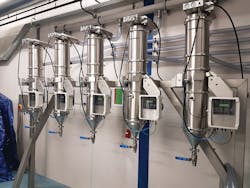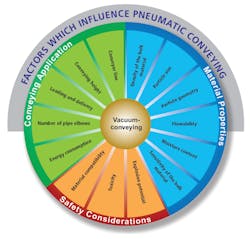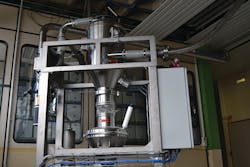Adaptability in powder handling: The key to a good supplier and a successful production facility
When it comes to selecting a reliable vendor for any new processing application, most would say that it pays to look at the vendor’s track record. Yet, what does this really mean? When considering a vendor for a powder handling project, no two cases are ever the same, and thus a “track record” might not translate to the project at hand. For instance, the number of years that a supplier has been in business is often used to imply a level of knowledge and expertise, which could be true. However, even if a company has existed for 50 years or more, it doesn’t mean it has taken on complex or difficult applications. It may simply be “selling from the catalog.”
There are many factors one must take into consideration when specifying the pneumatic conveying system required for a specific powder. As Figure 1 illustrates, one must look at the material properties, safety considerations and the actual conveying application to design an appropriate system to meet the customer’s production requirements.
When starting the design of a new vacuum conveying system for powders, perhaps a better approach than asking about years of experience is for the end user to ask a supplier: “What applications have you handled that required innovative designs and were they successful?”
Is the supplier capable of thinking outside of the box? As engineers, we all like to solve problems. However, to truly meet the specific property, safety and application demands in a project, and to provide a successful production result, one must adapt conveying properties to the job at hand.
The following case studies demonstrate unusual applications requiring significant problem-solving skills in adapting pneumatic vacuum conveying principles and systems to production applications.
Case 1: Adapting conveyors to a production flow for five granulates with particulates
A supplier in the pharmaceutical sector was confronted with the dilemma of needing to deliver its product in a container specified by the customer, and that product consisted of five different granulates with fine particulates present. These granulates needed to be conveyed from 200L bulk containers to the customer’s smaller 10L packages without introducing product contamination. In this case, the solution was further complicated by the fact that the containers were in a line to undergo a special heat treatment process to remove foreign particles from the raw material.
The supplier was looking for a solution to forego its existing production arrangement in the material transfer to the smaller containers, where the operator had to first open the bulk container to prepare the in-liner for connection to a special hopper-emptying lid. The container itself was then inserted into a lift-and-tilt device and rotated through 180 degrees allowing the small container to be filled via a ball valve. The process was time-consuming and cleaning-intensive.
It was immediately obvious that some innovative adaption of the base transfer system would be needed to provide a practical and employee-friendly solution. To eliminate the time-consuming loading of the bulk container into the lift-and-tilt device, granules were safely vacuum conveyed — free from damage and segregation — from the top of the container by means of a suction wand. Because the various granular products required processing according to type, a separate vacuum conveyor was provided for each of the five granulates. By locating the five receivers in a series, productivity increased significantly and the requisite cleaning reduced by a factor of five. The special design of the vacuum conveyors allowed for the adaption to the filling system.
To further assist in avoiding delays when changing the bulk containers, a buffer volume was included in the vacuum conveyor and monitored by a level probe. In this way, adequate time was provided to change the bulk containers when needed. Feedback from the level probe to the PLC control assisted the operator in monitoring this task and thereby allowed for multiple functions to be undertaken.
Finally, by adapting the standard discharge of the vacuum conveyor to the existing connection point of the 10L containers, and incorporating the same ball valves, minimal change was required to the filling line itself.
Case 2: Resin granulate with an MIE of 3mJ
In this challenging application, a client wished to change the way it processed a highly flammable resin granulate that was being added to a mixer. Its procedure was to fill drums with resin and heat them in ovens until the resin turned to liquid, before adding to a second liquid in a stirred vessel. The method was time-consuming, labor-intensive and unpleasant for the operators, resulting in production bottlenecks.
The challenge for the client was to find a solution that was safe, time-saving and flexible for the production process. With minimum ignition energy (MIE) of 3mJ, the material required special handling. Furthermore, the addition of the resin to the mixer required accurate dosing of small batches at a time — plus the client had a requirement to improve the cleanliness of the room where the product was handled.
After detailed discussions with the client involving a review of existing standard equipment and a discussion of how this equipment might be adapted to this tricky application, a time- and space-saving solution was identified. The solution took into account the need to transfer the resin granulate in a way that avoided an explosion risk yet kept the capital outlay to a reasonable level.
Taking all these factors into consideration, the first priority in the solution was to eliminate the drums and heating process. The use of bulk bags, with the resin granulates positioned in a nearby, centrally located material storage area, was the solution. A twin arrangement of the bulk bag unloaders, capable of quickly switching from one bulk bag supply to the other, was developed to maintain a consistent supply of the resin granulate to the mixers, without losing time for bag changeover.
The production process also required two mixer destinations, so two Conweigh vacuum conveying weigh hoppers were located above the mixers to vacuum convey the material to its respective discharge points some 190 feet and 250 feet away, including a vertical elevation change of 35 feet. The weigh hoppers were tasked with delivery of multiple small 100-gram doses of the granulate to the stirred vessel, ensuring the granulate dissolved effectively as it was heated and incorporated into the mix, and did so at a conveying rate of two tons per hour.
The ability to use an ATEX-certified vacuum conveying system capable of transporting low MIE powders in a hostile environment was central to this labor-saving solution. After installation, not only could the client successfully convey the product, they could also confirm that the conveying lines emptied completely, leaving only a trace for cleaning.
Conclusion
In both cases, the design of a workable solution required adaption of a standard technique to suit the client’s need. As is so often the case in bulk powder handling, it is the application and adaption of known techniques that result in a successful investment for the client. By involving suppliers with both experience and the willingness to adapt products to suit the applications, end users can achieve solutions that not only optimize production time and processes, but also safeguard employees and the final product.
Nick Hayes is president of Volkmann Inc., a company engineering and manufacturing high- performance, ATEX-certified vacuum conveying systems, including those for additive manufacturing. He is a mechanical engineer and a Fellow of the Chartered Management Institute. Originally trained at the Royal Aircraft Establishment in Farnborough, England, he has more than 40 years of experience in pneumatic conveying and bulk powder handling. In 2008, he joined Volkmann, establishing the North American division of the Volkmann Group, Volkmann Inc. Since that time, he has overseen the growth of the company from its U.S. base in Bristol, PA.



